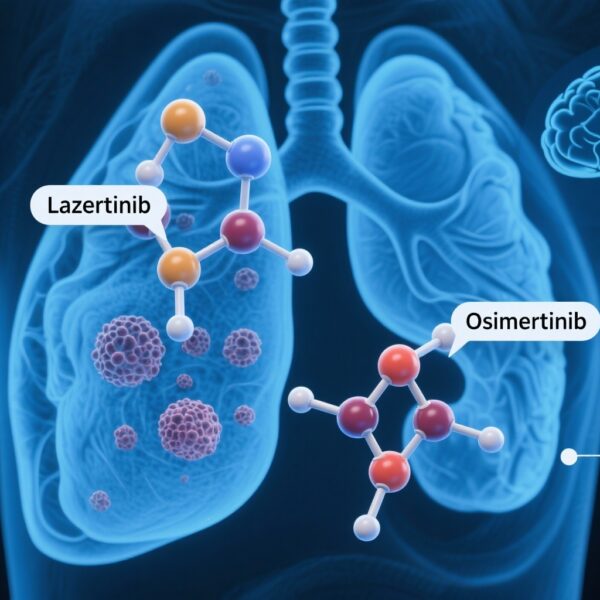Highlights
– An international, multicenter retrospective cohort (n=2,052) reports rising prevalence of leptomeningeal metastatic disease (LMD) in advanced NSCLC and improved overall survival after LMD diagnosis in the contemporary era.
– CNS‑penetrant tyrosine kinase inhibitors (TKIs) substantially reduce mortality risk in patients with actionable genomic alterations (HR 0.39; 95% CI 0.31–0.48).
– Immune checkpoint inhibitors (ICIs) are associated with survival benefit in patients without actionable genomic alterations (HR 0.45; 95% CI 0.25–0.84).
Background
Leptomeningeal metastatic disease (LMD) is the dissemination of malignant cells to the leptomeninges and cerebrospinal fluid (CSF). In non-small-cell lung cancer (NSCLC), LMD historically portended a median survival measured in weeks to a few months. Several converging trends have reshaped this landscape: routine molecular profiling of NSCLC, widespread availability of targeted therapies with improved central nervous system (CNS) penetration, and increasing use of immune checkpoint inhibitors (ICIs). How these changes have affected the epidemiology, timing, and outcomes of LMD in NSCLC has been unclear.
Study design
Zheng and colleagues performed an international, retrospective multicenter cohort study across eight institutions in Asia, the United States, and Europe, capturing patients diagnosed with LMD from advanced NSCLC between 2007 and 2024. The authors collected clinicopathological characteristics, molecular subtype, treatment exposures, and outcomes. The primary endpoint was overall survival from the time of LMD diagnosis (LMOS). Cases were analyzed by molecular subtype: EGFR-mutant, ALK-rearranged, other actionable genomic alterations (other AGA: e.g., ROS1, ERBB2), and non-AGA. Diagnostic categorization followed the European Association of Neuro-Oncology (EANO)–European Society for Medical Oncology (ESMO) criteria (type I: CSF cytology positive; type II: MRI and/or symptom positive).
Key findings
Cohort and prevalence
The study included 2,052 patients with NSCLC and LMD stratified by molecular subtype: EGFR (n=1,610), ALK (n=141), other AGA (n=137), and non-AGA (n=164). Cumulative prevalence estimates of LMD among molecular subgroups were reported as: EGFR 11.1%, ALK 11.2%, ROS1 16%, ERBB2 12.3%, and non-AGA 3.6% — highlighting a markedly higher prevalence in oncogene-driven disease.
Timing of LMD
A higher proportion of LMD diagnoses occurred more than 3 years after the initial metastatic NSCLC diagnosis, consistent with prolonged systemic control and extended patient survival enabling later CNS progression. In the EGFR cohort specifically, prior exposure to CNS‑penetrant TKIs delayed LMD onset (P < 0.0001), suggesting that drug selection influences timing of leptomeningeal seeding or its clinical manifestation.
Survival after LMD diagnosis
Overall median LMOS across the cohort was 10.9 months (95% CI 10.0–11.8). Compared with historical cohorts, contemporary patients demonstrated improved LMOS (historical median 7.3 months versus contemporary 11.5 months; P < 0.0001), and this improvement was observed across molecular subtypes.
Impact of systemic therapies
In patients with actionable genomic alterations (AGA), receipt of TKIs after LMD diagnosis was strongly associated with improved survival (HR for death 0.39; 95% CI 0.31–0.48; P < 0.0001). Among EGFR‑mutant patients, continued use of CNS‑penetrant TKIs after LMD diagnosis correlated with a longer LMOS (median 12.4 months vs 6.0 months; P < 0.0001), supporting the clinical practice of maintaining targeted therapy when feasible.
In non‑AGA patients, ICIs were associated with improved survival (HR 0.45; 95% CI 0.25–0.84; P = 0.012). The analysis suggests that systemic immunotherapy can confer benefit even in the leptomeningeal setting, although effect sizes and patient selection require careful interpretation.
Diagnostic subgroup and prognosis
By EANO‑ESMO diagnostic criteria, patients whose diagnosis was type I (positive CSF cytology) had significantly shorter LMOS compared with type II (MRI/symptom-diagnosed) cases. This finding may reflect greater tumor burden or more biologically aggressive disease when malignant cells are detectable in CSF.
Safety and secondary observations
As a retrospective cohort, detailed prospective safety data were limited. The study primarily assessed survival outcomes; treatment-related neurotoxicity, quality of life, and intracranial symptom control were not systematically reported. Heterogeneity of supportive interventions (e.g., intrathecal therapy, radiotherapy) across centers was present but not the focus of the primary analyses.
Expert commentary and interpretation
This large, international cohort provides persuasive, contemporary evidence that the natural history of LMD in NSCLC is changing. The key drivers appear to be improved systemic disease control and the availability of CNS‑active therapies that either delay leptomeningeal dissemination or provide clinically meaningful disease control after LMD diagnosis.
Biological plausibility: potent, CNS‑penetrant TKIs (eg, third‑generation EGFR inhibitors with higher CSF exposure) can suppress intracranial and leptomeningeal tumor cell proliferation and may reduce the likelihood of clinically overt LMD. The association between continued CNS‑penetrant TKI use after LMD and longer survival is consistent with intracranial activity observed in pivotal trials and case series.
ICI activity in LMD is less well characterized. The observed benefit in non‑AGA patients suggests immune modulation can affect CNS disease, but response patterns in leptomeninges often differ from parenchymal brain metastases, and steroid use, tumor microenvironment, and CSF immune milieu influence outcomes.
Limitations and caveats
Important limitations temper causal inference. The study is retrospective and observational, so treatment selection bias (healthier patients more likely to receive systemic therapy), center heterogeneity, and temporal changes in imaging and diagnostic sensitivity may influence results. CSF cytology sensitivity is low and can vary with sampling technique; patients classified as type II may represent earlier disease or differences in diagnostic intensity. Detailed data on intrathecal chemotherapy, radiotherapy (including craniospinal vs focal RT), symptom burden, performance status, and steroid exposure were variably available and limit granular subgroup analysis.
Generalizability: the large international sample strengthens generalizability, but molecular subtype distribution and access to novel agents vary globally, which affects applicability in resource-limited settings.
Clinical implications and practice points
– Routine comprehensive molecular profiling remains essential in metastatic NSCLC to identify opportunities for targeted CNS‑active therapies that may delay or improve outcomes after LMD.
– For patients with EGFR, ALK, ROS1, or other actionable alterations, prioritize CNS‑penetrant TKIs when available and consider continuing these agents after LMD diagnosis when clinical benefit and tolerability permit.
– In non‑AGA patients, ICIs may provide benefit; however, careful patient selection and monitoring are needed. Prospective data on immunotherapy for LMD are limited.
– Multidisciplinary care—including neuro-oncology, medical oncology, radiation oncology, and palliative care—remains central to symptom control, individualized treatment planning, and clinical trial enrollment.
Research priorities
– Prospective trials specifically designed for LMD with stratification by molecular subtype, standardized diagnostic criteria, patient-reported outcomes, and CNS-focused endpoints.
– Pharmacokinetic/pharmacodynamic studies of CNS penetration and CSF drug levels to optimize dosing strategies for leptomeningeal disease.
– Biomarker research to predict which patients derive durable benefit from ICIs in the leptomeningeal compartment and studies of combination approaches (e.g., targeted therapy plus intrathecal agents or radiation).
Conclusion
In a large international cohort of NSCLC patients with LMD, the prevalence of leptomeningeal involvement is rising and median survival after LMD diagnosis has improved in the contemporary era. CNS‑penetrant TKIs and ICIs are associated with meaningful survival gains in their respective molecular cohorts. While these data support continued and early use of CNS‑active systemic therapy, definitive guidance will require prospective trials and standardized approaches to diagnosis, response assessment, and supportive care.
Funding and clinicaltrials.gov
Funding: As reported in the original manuscript, multi‑institutional contributors supported the retrospective data collection; study-level funding details and conflicts of interest should be consulted in the primary publication (Zheng et al., Ann Oncol. 2025).
ClinicalTrials.gov: Not applicable (retrospective cohort study).
References
1. Zheng MM, Xia Y, Pan K, et al. The evolving landscape of leptomeningeal metastases from NSCLC: an international, contemporary, multicenter cohort study. Ann Oncol. 2025 Oct 20. doi: 10.1016/j.annonc.2025.09.140. Epub ahead of print. PMID: 41125209.
2. Soria JC, Ohe Y, Vansteenkiste J, et al. Osimertinib in untreated EGFR‑mutated advanced non‑small-cell lung cancer. N Engl J Med. 2018;378(2):113–125. doi:10.1056/NEJMoa1713137.
Note
This article summarizes and interprets results from a large retrospective cohort. Clinicians should consult the primary publication for full methodological details, supplemental analyses, and institutional disclosures before applying findings to individual clinical decisions.



